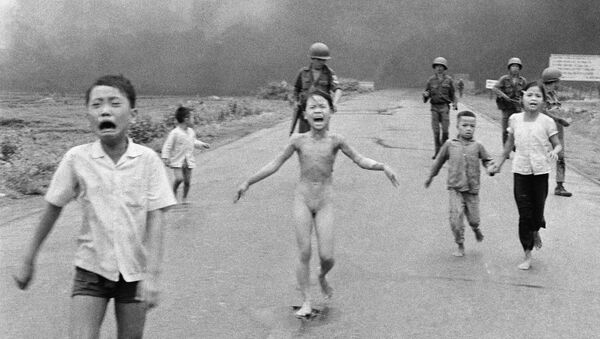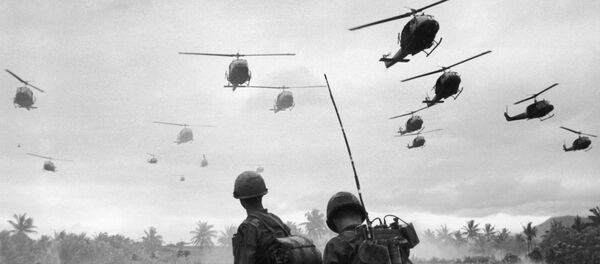“This is one of the most amazing photographs taken directly during the US aggression in Vietnam in 1964-1975. The photo was taken in 1972, when the US Air Force and the ‘Republic of Vietnam’ bombed the central part of the country,” Hien told Sputnik.
“It depicts a group of people who came under the bombs and at the forefront there is a girl, who was later on called the ‘Napalm girl’. She has absolutely no clothes, her clothes have burned. In the photo there are many soldiers: American and South Vietnamese.”
“It was recorded by foreign journalists, the facts were in print: Vietnam and the world began to see evidence of war crimes in Vietnam by America and its puppet regime the ‘Republic of Vietnam,’” VU Quang Hien.
The historian said that the photos prompted the world community to act more actively to end the war. “That is the value of this picture. It is not only against the war in Vietnam but against war itself. It is a historical document, it is — the truth.”
Quang Hien further said that it is a pity that Facebook moderators did not understand. “They obviously have bad historical memory and bad understanding of historical reality, or they just do not know history. It is surprising because this picture is well known,” the historian said.
Norwegian newspaper Aftenposten published an open letter to Facebook that accused CEO Mark Zuckerberg of "abusing your power."
"I am worried that the world’s most important medium is limiting freedom instead of trying to extend it, and that this occasionally happens in an authoritarian way."
Huin further said that on Facebook they just saw a naked child?! “They did not bother to think: why is this girl in the photo with no clothes? Why around her there are crying children and soldiers? Because this is a war, bombing, because her clothes are burnt and there are terrible burns on the girls’ body from napalm,” the historian said.
He noted that maybe there is another version to this narrative behind Facebook’s move. “In the Internet and social networks there are a lot of photos of pornographic nature. Facebook itself sins with that. Therefore, I have a question: what purpose did Facebook moderators pursue by removing this documentary photo?”
“In my opinion, the Norwegian newspaper did the right thing, calling the photo with ‘Napalm girl’ ‘one of the seven shots that changed the history of warfare.’ I think the decision of the moderators to shut the newspaper’s account and remove the historical document is a big mistake,” the historian concluded.
Two weeks ago journalist and author Tom Egeland posted the photo and it was quickly taken down by Facebook, in accordance with what it terms “community standards.”
The photograph, taken by AP photographer Nick Ut in 1972, instantly became an iconic depiction of the Vietnam War, showed injured Vietnamese children running from a napalm attack.
Among the children and South Vietnamese soldiers in the image, a severely injured and naked 9-year-old girl, Kim Phuc, is at the center, and it is her nudity that is the stated reason for the ban. “Any photograph of people displaying fully nude genitalia or buttocks, or fully nude female breast, will be removed,” according to Facebook policy.
But later on, Facebook released a new statement, "After hearing from our community, we looked again at how our Community Standards were applied in this case. An image of a naked child would normally be presumed to violate our Community Standards, and in some countries might even qualify as child pornography," reads a statement from Facebook, provided to Mashable.
"Because of its status as an iconic image of historical importance, the value of permitting sharing outweighs the value of protecting the community by removal, so we have decided to reinstate the image on Facebook where we are aware it has been removed."


